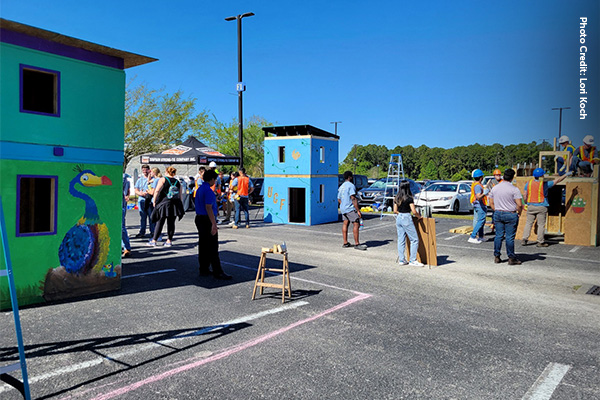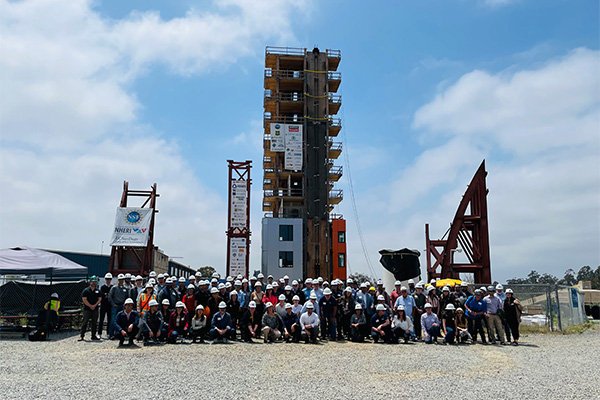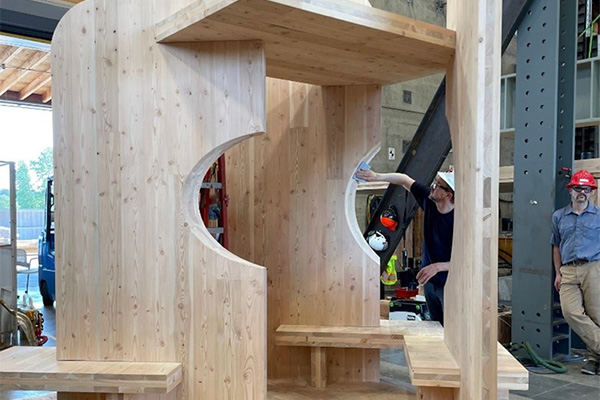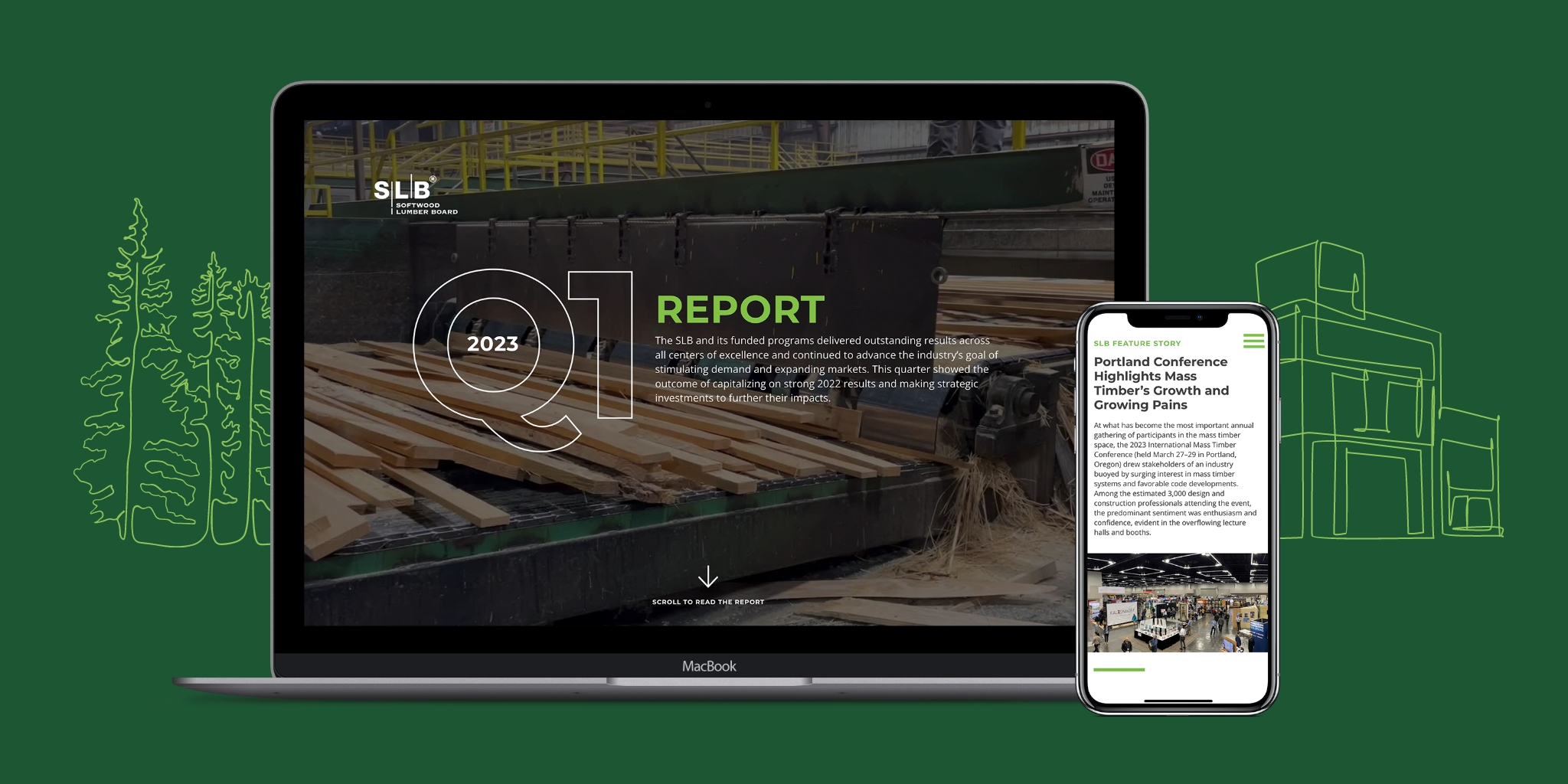HIGHLIGHTS
PROGRAM UPDATES
Class Act: AWC-Sponsored Timber Strong Design Competition Doubles in Size Home Advantage: Think Wood Highlights Multifamily Developers Growing Demand for Wood Products Shaking Things Up: WoodWorks Builds on Seismic Test Success With Technical Workshop for over 100 Building Professionals Timber Tutelage: Hands-on Faculty Development Workshop Helps Expand Post-Secondary Wood EducationINDUSTRY RESOUCES
Virginia Tech's Monthly Housing ReportProgram Updates
Class Act: AWC-Sponsored Timber Strong Design Competition Doubles in Size

Design students from across the country gathered for the biggest Timber Strong Design Competition to date. With eight regional competitions (up from five last year) and 43 teams (up from 21) competing, the competition sponsored by the AWC, in partnership with the American Society of Civil Engineers, APA – The Engineered Wood Association, and Simpson Strong-Tie, was an action-packed event. Teams were challenged to design and build a sustainable, aesthetically pleasing, and structurally durable two-story light-frame wood building, providing them with real-world construction experience and helping to promote wood construction.
At a recent Think Wood Mobile Tour stop at Boise State University, the school’s Timber Strong team hosted a reception, sponsored by the AWC and other partners, to view the exhibit with the College of Engineering. The next day, the AWC organized a walking tour of Society of Environmental Journalists Conference attendees, who visited the Mobile Tour and learned about mass timber construction possibilities in the Boise area, such as the timber/steel hybrid Idaho Central Credit Union Arena at the University of Idaho.
The competition is inspiring the next generation of building professionals to innovate with wood construction and design.
Home Advantage: Think Wood Highlights Multifamily Developers Growing Demand for Wood Products

Alongside architects, real estate developers are an equally important target audience in Think Wood’s content strategy. Through blog posts that highlight the unique role wood can play in multifamily projects, Think Wood is aiming to inspire more developers to pursue wood construction in their projects.
Recently, Think Wood conducted a Q&A with sustainability-focused multifamily developer Nate Helbach of The Neutral Project that dives into the philosophy behind his focus on building carbon-neutral developments. This strategy has led to his latest mass timber building, The Edison in Milwaukee, which is projected to reach 32 stories, surpassing the 25-story Ascent.
Another interview with Renee Funston, development manager for Sacramento’s Capitol Area Development Authority, provides a different perspective on mass timber in affordable housing—such as the Sonrisa complex (shown above)—from a public agency.
At a time when financing is tight and any construction project that breaks ground feels like a major achievement, developers in multifamily real estate are uniquely positioned to drive demand for timber products. Think Wood will continue to create content that serves this important audience segment to raise awareness of the benefits of wood construction in multifamily projects—be it in light-frame or mass timber construction.
Shaking Things Up: WoodWorks Builds on Seismic Test Success With Technical Workshop for Over 100 Building Professionals

As you read in last month’s newsletter, the Natural Hazards Engineering Research Infrastructure (NHERI) TallWood Project recently conducted a seismic resilience test of a 10-story mass timber structure with the support of the SLB, WoodWorks, Think Wood, and the Binational Softwood Lumber Council.
WoodWorks returned to the shake table test site at UC San Diego to conduct a technical workshop for 112 engineers, contractors, and architects. The full-day workshop began with presentations on state-of-the-art mass timber seismic design, including the rocking wall system used in the NHERI structure, and participants were then able to witness the building’s performance under a max credible earthquake after it had withstood 96 other earthquake simulations.
Along with AEC professionals, the SLB provided funding for 10 insurance professionals—including brokers and underwriters—to attend a WoodWorks mass timber insurance workshop in conjunction with the shake table test. The workshop focused on educating the insurance industry in an effort to remove barriers related to insuring tall wood buildings during construction and post occupancy. The participants commented on the resilience of the rocking wall system and its ability to withstand large-scale earthquakes. WoodWorks is building on these efforts with a soon-to-be-released solution paper, Repair of Fire-Damaged Mass Timber: Considerations for Insurers.
The full findings of the construction and testing of the building are slated to be released this year, and this successful collaboration between the SLB and its funded programs serves as a testament to the potential of wood’s seismic resilience.
Timber Tutelage: Hands-on Faculty Development Workshop Helps Expand Post-Secondary Wood Education

Thirteen faculty members from architecture programs across the country gathered at Oregon State University’s TallWood Design Institute (TDI) for an innovative SLB-funded three-day workshop. The first of three planned for 2023, the workshop invited participants to design, fabricate, and assemble a full-size small-scale mass timber pavilion.
“The TDI Mass Timber Design Build Workshop, sponsored by the SLB, is a superb event,” said Justin Diles, Associate Professor at The Ohio State University. “Where else can architects visit a managed forest and a finished mass timber building on the same day? Spanning industry and the academy, the TDI team has deep expertise in all aspects of contemporary heavy wood construction. They share this knowledge with great, great generosity and enthusiasm. I would recommend this workshop to any architect or educator interested in learning more about mass timber.”
With practical experience, technical lectures from industry experts, a visit to OSU’s MacDonald Dunn Research Forest, and tours of the several award-winning mass timber buildings on campus, faculty members gained an in-depth understanding of how they could better integrate mass timber education into their own programs. The workshop also enabled participants to connect and collaborate with colleagues from other institutions, exchanging ideas and resources that will help to expand wood topics in college architecture programs.
Spotlight
Cutting Carbon: Getting to Net-Zero Homes with Wood Construction

Thrive Home Builders—an Energy and Environmental Building Alliance (EEBA) member and an early convert to low-embodied carbon materials—is launching a net-zero carbon residential community in Fort Collins, Colorado, that will be built using light-frame wood construction. The 400-home sustainable development will be a blend of single-family homes, duplexes, and townhomes—all featuring small footprints and a focus on quality and sustainability. The homes, designed for efficiency, comfort, and health, are DOE Zero Energy Ready, EPA Indoor Air Plus, and LEED v4 certified.
The light-frame wood homes will be built to rigorous performance standards using sophisticated energy management solutions and smart home technologies, and the community will achieve carbon neutrality through four unique carbon offset projects. Homes will also take advantage of solar technologies to cover a portion of their energy needs. Thrive estimates that the 220 homes in the Sonders neighborhood will reduce CO2 emissions by 1,023 tons when compared to a similar community built to the 2021 IECC—equivalent to driving a standard gas-powered vehicle 2.5 million miles, or around the world 100 times.
“Thrive Home Builders delivers energy-efficient homes with a mission focused on healthy and local solutions,” said Bill Rectanus, chief operating officer for Thrive, in an interview with Think Wood last year. “We’ve been making conscious choices in the design of our homes for 30 years to make them healthy for families, the environment, and the planet. We think the carbon conversation is a great tie-in to what we are doing already—and we believe it’s becoming clear for our buyers: you can’t be healthy yourself without a healthy home and a healthy planet,”
Thrive has been pioneering a new design process that evaluates the use of carbon measurement tools and technologies like BIM to better understand the embodied carbon impact of materials and how it can curb emissions through design and offset measures. The firm has been recognized by the U.S. Department of Energy’s Housing Innovation Awards since 2017 for its commitment to the department’s Zero Energy Ready Home program.
The Fort Collins development demonstrates how light-frame wood construction can contribute to a carbon-neutral future for larger-scale developments that blend single-family and multifamily configurations.
Industry Resources
Virginia Tech's Monthly Housing Report
This monthly housing commentary report is a free service of Virginia Tech and is intended to help one gauge future business activity in the U.S. housing market.
April 2023 Reports (released in June 2023)
Part A: April Housing Commentary
Part B: April Economic Conditions


